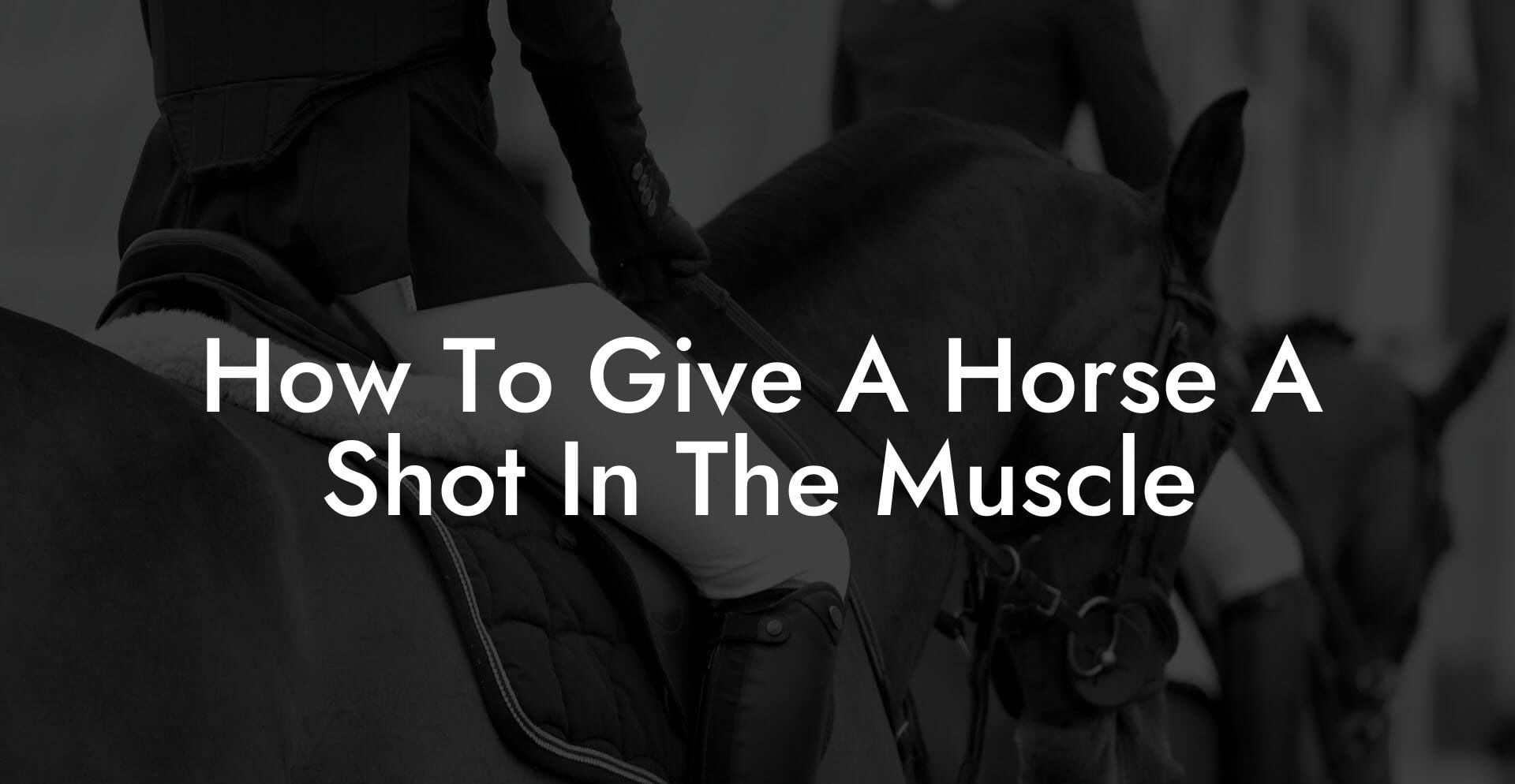Picture this: You’re hanging out at the barn, sipping your oat milk latte, when your trusty steed suddenly needs a muscle shot – and not just any shot, but one that hits the mark (quite literally) to keep him in tip‐top shape. Whether you’re a seasoned equine enthusiast or a curious newbie trying to level up your barnyard skills, giving a horse a shot in the muscle can be as artful as it is science-y. Buckle up, because we’re about to dive into an in-depth, step-by-step guide that’s equal parts practical, humorous, and downright essential for any horse lover who wants to keep their four-legged friend galloping happily.
Quick Links to Useful Sections
- Understanding Muscle Shots for Horses: What, Why, and How?
- When and Why Would You Give a Horse a Muscle Shot?
- Preparation and Safety: The Golden Rules
- Consult Your Veterinarian
- Check the Medication and Dosage
- Gather Your Supplies
- Set Up a Calm Environment
- Equine Anatomy 101: Spotting the Right Muscle
- Step-by-Step Guide: How to Give a Horse a Muscle Shot
- Step 1: Confirm the Need for the Injection
- Step 2: Prepare Your Workspace
- Step 3: Restrain Your Horse Safely
- Step 4: Draw Up the Medication
- Step 5: Locate the Injection Site
- Step 6: Administer the Injection
- Step 7: Withdraw the Needle and Apply Pressure
- Step 8: Dispose of Sharps Properly
- Common Pitfalls and How to Dodge Them Like a Pro
- Aftercare and Monitoring: The Next 24 Hours
- Immediate Post-Injection Care
- Monitor for Delayed Reactions
- Record-Keeping and Follow-Up
- Veterinary Best Practices & Professional Guidance
- Integrative Approaches: Learning from the Community and Beyond
- Resources and Community Support: Your Next Steps
- FAQs: Your Top Questions About Giving a Horse a Muscle Shot Answered
- Your Journey to Empowered Equine Care
Understanding Muscle Shots for Horses: What, Why, and How?
In the world of equine care, muscle shots are often administered to treat conditions ranging from bacterial infections to inflammation, or even to boost vaccination programs. Unlike intravenous injections that zip directly into the bloodstream, a muscle shot allows the medication to seep slowly into the muscle tissue, providing a steady release that’s easier on your horse’s system.
For those who thrive on understanding the finer points, think of the muscle as a natural reservoir; the medication is gently absorbed, offering a blend of immediate relief and long-term benefits. This method is especially useful when the drug needs to linger in the tissue, ensuring that the horse gets the full effect over time. Just like your favorite indie album that slowly reveals its hidden gems, a well-administered muscle shot works its magic at a pace that lets the body naturally integrate the treatment.
This guide is designed to walk you through everything you need to know – from preparation and materials to step-by-step instructions, troubleshooting common pitfalls, and even exploring alternative methods. It’s a comprehensive resource for anyone who wants to master the technique while keeping it safe, efficient, and yes, even a bit fun.
When and Why Would You Give a Horse a Muscle Shot?
There are numerous scenarios where a muscle injection is not just beneficial but essential. Here’s what might lead you to consider it:
- Vaccinations and Preventative Care: Horses need routine shots just like humans. Muscle shots are commonly used to administer vaccines against diseases such as tetanus, influenza, and rabies.
- Antibiotics for Infections: If your horse has a bacterial infection, a muscle injection may deliver the antibiotic more steadily than an IV might, ensuring that the medicine has time to fight off pesky pathogens.
- Pain Management and Anti-inflammatory Treatments: When inflammation strikes, whether due to injury, strain, or chronic conditions, a muscle shot can help reduce swelling and manage pain.
- Nutritional Supplements and Hormonal Treatments: Certain supplements or hormone therapies are best given via muscle injection to guarantee that they are absorbed properly over a long period.
- Performance Enhancement: In some cases, especially in performance horses, muscle injections might be used (under strict veterinary oversight) to improve muscle repair after strenuous exercise.
While muscle shots are incredibly useful, they require precision and care. They’re not a DIY project for the faint of heart (or those without proper training), so always remember: the guidance of a professional veterinarian is paramount. That said, knowing the ins-and-outs will help you communicate more effectively with your vet and understand the process should you need to assist or observe.
Preparation and Safety: The Golden Rules
Safety first – not just for you, but for your horse, too. Preparing to give a muscle shot involves several crucial steps that ensure both effectiveness and safety. Think of it as gearing up for a mission where every detail matters.
Consult Your Veterinarian
Before you even think about assembling your equipment, have a heart-to-heart with your veterinarian. They’ll explain why a muscle shot is the best option for your horse’s condition, discuss any potential side effects, and advise on precise dosages. Their expertise is like your personal equine YouTube tutorial – indispensable!
Check the Medication and Dosage
The medication itself is critical. Check that it’s not expired, verify the correct dosage, and make sure you understand any specific instructions on how to reconstitute or handle the drug. A mishandled dose can turn a beneficial treatment into a costly mistake.
Gather Your Supplies
In addition to the medication, you should have:
- Sterile syringes and needles (the appropriate gauge and length for muscle injections)
- Alcohol swabs to disinfect the injection area
- Gloves for hygiene and protection
- Sharps disposal container
- A clean towel and perhaps a trusted assistant to help keep your horse calm
Set Up a Calm Environment
Creating a calm, familiar environment for your horse is essential. Horses are sensitive animals and can pick up on your nervous energy. Find a quiet spot in the barn or paddock, preferably where your horse feels most comfortable. Some people even play soft music to reduce stress, it could be just the vibe to set the mood.
Remember, being methodical and calm during this phase not only helps you but reassures your horse that everything is under control.
Equine Anatomy 101: Spotting the Right Muscle
Knowledge is power, especially when it comes to understanding where to deliver a muscle shot. Horses have several large muscle groups, but the most common target is the gluteal muscle (or the “butt” area). This site is a popular choice because it is generally well-developed and can accommodate a slow-release of medication.
Here are some anatomical notes to help you pinpoint the area:
- The Gluteal Muscle: Located in the hindquarter, it’s a large, solid muscle that’s ideal for injections. Look for the thickest part just above the tailhead; this is typically where your vet may recommend the injection.
- The Neck Muscles: In some cases, particularly with smaller doses or when the gluteal muscle isn’t an option, the muscles along the neck can be used. However, these areas are more sensitive, so extra caution is needed.
- The Shoulder Area: Another option, albeit less common, involves the shoulder muscles. This area tends to be reserved for certain types of medications or treatments.
Understanding your horse’s muscular layout not only helps you administer the shot correctly but also ensures minimal discomfort for your animal. If you ever feel unsure, always pause and consult your veterinarian for a quick anatomy refresher.
Step-by-Step Guide: How to Give a Horse a Muscle Shot
Now that the stage is set, let’s get into the nitty-gritty. Follow this step-by-step guide to ensure the procedure is smooth, safe, and effective.
Step 1: Confirm the Need for the Injection
Begin by re-confirming with your veterinarian that a muscle injection is the correct course of action for your horse’s current condition or preventive care routine. Double-check the dosage and any pertinent instructions printed on the medication label.
Step 2: Prepare Your Workspace
Arrange all supplies on a clean, flat surface. Lay out your sterile syringes, needles, alcohol swabs, and gloves in an order that makes sense for a seamless process. Wipe down the injection site area on your horse using an alcohol swab. This disinfection minimizes the risk of infection and ensures a cleaner entry point for the needle.
Step 3: Restrain Your Horse Safely
To avoid sudden movements or stress that could jeopardize the safety of both you and your horse, ensure your horse is either adequately restrained or having someone assist you by gently holding the horse. Some horses appreciate a calming pat or a favorite treat to reinforce positive behavior.
Step 4: Draw Up the Medication
Put on your gloves and take your pre-filled syringe or the one you need to fill. If you’re using a vial that requires reconstitution, follow the vet’s instructions carefully. Draw the correct amount of medication into the syringe. Make sure to eliminate any air bubbles from the syringe by tapping it and pushing out small amounts of air. This step is crucial to ensure that the horse receives the full, accurate dose.
Step 5: Locate the Injection Site
With your horse’s gluteal muscle targeted, gently part the hair (if necessary) to expose the clean, prepared skin. Stand to the side where you have a clear view of the anatomy. Visualize an imaginary line: the bulk of the muscle mass should be at least a few inches away from the bone to avoid any complications. If you’re in doubt, a quick consultation with your vet or referring to anatomical diagrams can help pinpoint the best location.
Step 6: Administer the Injection
Hold the syringe like you would a paintbrush, firm and with precision. Insert the needle at a 45-degree angle into the muscle. Insert it steadily until you feel a gentle resistance change (this indicates you are in the muscle tissue, not just subcutaneous fat). Then, slowly depress the plunger to inject the medication at a controlled, steady rate. The slow push ensures the medication has time to disperse evenly into the muscle fibers.
Pro tip: Maintaining a steady hand and calm breathing will help you pace the injection thoughtfully and confidently.
Step 7: Withdraw the Needle and Apply Pressure
Once you’ve dispensed the full dose, swiftly withdraw the needle and immediately apply gentle pressure to the injection site with a clean cotton ball or gauze pad. This helps prevent any medication leakage and minimizes bleeding. You may also massage the area lightly to encourage absorption, but be gentle – you don’t want to cause unnecessary discomfort.
Step 8: Dispose of Sharps Properly
Safety doesn’t end with the injection. Immediately place the used needle and syringe into a designated sharps container. Following proper disposal protocols is not only a best practice but also a legal requirement in many jurisdictions. This step protects both you and others from accidental needle sticks.
Following these systematic steps assures that you’re delivering the medication effectively while keeping both your horse and yourself safe. Each action plays a critical role in the process, turning what might be a stressful task into a confident, well-managed procedure.
Common Pitfalls and How to Dodge Them Like a Pro
Even with detailed instructions in hand, there are some common mistakes that can turn a muscle shot from smooth sailing to a potential debacle. Here’s what to watch out for and how to avoid them:
- Misidentifying the Injection Site: Failing to find the right muscle tissue can lead to subcutaneous injections, which might not deliver the medication at the desired slow-release rate. Always double-check anatomical landmarks and refer to diagrams if needed.
- Rushing the Process: Hasty injections, especially when you’re nervous or under pressure, can result in improper needle placement or even injury to the horse. Take your time and follow each step methodically.
- Poor Hygiene Practices: Skipping the disinfection of the injection area or using non-sterile equipment can result in infections that could complicate your horse’s recovery. Cleanliness is crucial.
- Air Bubble Mishaps: Not eliminating air bubbles from the syringe can lead to inaccurate dosing. Remove bubbles carefully before the injection for a safe and effective delivery.
- Inadequate Restraint: If your horse moves unexpectedly during the injection, it can result in injury. Always ensure that your horse is securely restrained and calm before you begin.
By being aware of these pitfalls, you can approach each injection with confidence. Think of it like perfecting your favorite dance move – mastering the technique takes practice, patience, and a healthy dose of humor when things don’t go exactly as planned.
Aftercare and Monitoring: The Next 24 Hours
The injection doesn’t stop the moment the needle leaves the skin. Aftercare is essential to ensure that your horse recovers comfortably and that the medication does its job effectively.
Immediate Post-Injection Care
Right after the injection, keep a close eye on the injection site. Gently rub the area to encourage even distribution of the medication and check for any immediate signs of swelling or discomfort. This is also a good moment to give your horse a reassuring pat and perhaps a treat – positive reinforcement goes a long way.
Monitor for Delayed Reactions
Over the next 24 to 48 hours, be vigilant for any signs of adverse reactions. These may include:
- Excessive Swelling or Redness: While minor swelling can be normal, significant inflammation might indicate an infection or an allergic reaction.
- Changes in Behavior: Watch for signs that your horse is in pain or discomfort – such as limping, restlessness, or refusing to feed. These could be clues that something isn’t quite right at the injection site.
- Fever or Lethargy: If your horse develops a fever or seems unusually sluggish, these may be early indicators of complications that require veterinary attention.
Maintain your regular monitoring routines and don’t hesitate to reach out to your veterinarian if anything seems off. Remember, diligent aftercare is a sign of proactive, loving care.
Record-Keeping and Follow-Up
It might sound a bit bureaucratic, but keeping a record of the injection – noting the time, dosage, and any reactions – is not only helpful for tracking progress but also invaluable for future veterinary visits. Documenting the process can help you and your vet refine future treatments and spot any patterns that could influence your horse’s overall care.
Veterinary Best Practices & Professional Guidance
While this guide is brimming with actionable insights, it’s important to underscore that nothing beats the expertise of a seasoned veterinarian. The process of giving a horse a muscle shot might be broken down into digestible steps, but every horse is unique – and only a professional can tailor the process to your animal’s specific needs.
Here are some best practices your vet will emphasize:
- Regular Training and Certification: Veterinary professionals undergo rigorous training to ensure their techniques align with the latest safety protocols and research. This ensures that every shot is administered with precision.
- Updated Protocols: Medical guidelines evolve, and staying informed about the most current recommendations helps you adjust your techniques if ever you are assisting in the care process.
- Collaboration and Communication: Whether you’re a horse owner, caregiver, or a budding equine enthusiast, open communication with your veterinarian is key. Don’t hesitate to ask questions or request demonstrations.
- Emergency Protocols: Accidents are rare, but being prepared is essential. Your vet should provide clear steps on what to do in case of an adverse reaction or emergency following an injection.
Pairing the knowledge from this guide with professional guidance ensures that you’re equipped to handle the process confidently, transforming a potentially nerve-wracking experience into a well-coordinated procedure that benefits your horse’s overall health.
Integrative Approaches: Learning from the Community and Beyond
Beyond the practicalities, there’s a rich vein of community knowledge out there. Equine enthusiasts, farriers, and seasoned veterinarians all contribute to a collective wisdom that can enhance your approach to administering injections. Whether you’re browsing specialized online forums, attending workshops, or following top equine care influencers on social media, integrating community tips can refine your technique.
Here are some innovative integrative approaches:
- Peer-to-Peer Learning: Join online forums or Facebook groups where horse owners share their real-life experiences and tips. The seasoned pros often reveal little-known tricks that save time and boost safety.
- Workshops and Training Sessions: Many veterinary clinics and equine centers offer hands-on workshops periodically. Hands-on learning under the guidance of professionals can hugely boost your confidence and competence.
- Holistic Care Integration: Sometimes, integrating muscle injections within a broader care routine that includes nutrition, physical therapy, and even mental well-being practices for your horse can lead to a more balanced and healthy animal. The more you learn, the more you see how all these factors work together.
- Digital Tools and Apps: There are now apps available that help track medication schedules, monitor aftercare, and even offer reminders for your next shot. Embracing technology can turn routine care into a streamlined, stress-free process.
Tapping into these community resources not only enriches your knowledge but also connects you with a support network that understands both the challenges and joys of equine care.
Resources and Community Support: Your Next Steps
Empowerment in equine care comes from connecting with a robust community and accessing the right resources. Here are a few recommendations to further your journey:
- Local Equine Veterinary Clinics: Your go-to spot for one-on-one guidance, these clinics can provide not only emergency care but also routine check-ups and injection demonstrations.
- Online Equine Care Communities: Websites like TheHorse.com, Equine Enrichment, and various social media groups offer a wealth of user-generated content, from detailed tutorials to Q&A sessions with seasoned experts.
- Workshops and Seminars: Look for events hosted by renowned veterinary schools or equine associations. These workshops are fantastic opportunities to learn first-hand, ask questions, and build confidence in your technique.
- Mobile Apps for Equine Health: Apps that track medication schedules, monitor vital signs, and set alerts for upcoming care sessions can be invaluable in keeping your horse’s health on track.
- Peer Mentorship: If you’re new to the world of equine care, consider connecting with an experienced mentor who can offer personalized advice and support.
These resources are designed to empower you with both information and community wisdom, ensuring that you never feel alone in your journey toward providing the very best for your horse.
FAQs: Your Top Questions About Giving a Horse a Muscle Shot Answered
Here are some frequently asked questions that can help clear up any lingering doubts you might have about the process:
1. Is it safe for a non-veterinarian to administer a muscle shot?
While this guide is designed to inform, it’s important to stress that muscle injections should only be performed under veterinary guidance or by those who have received proper training. Always consult a veterinarian if in doubt.
2. What are the key differences between a muscle shot and an intravenous injection for horses?
A muscle shot deposits medication into the muscle tissue, allowing for a slow, prolonged absorption, while an IV injection delivers the drug directly into the bloodstream for immediate action. The choice depends on the desired speed and duration of the treatment.
3. How do I reduce the stress my horse may experience during the injection?
Creating a calm environment, using gentle restraint techniques, and even providing your horse with definite rewards (like treats or gentle petting) can greatly reduce stress. Many caregivers also find that talking softly and using a soothing tone helps build trust.
4. What safety measures should I take to prevent infection?
Always disinfect the injection site with alcohol swabs, use sterile, single-use needles and syringes, and ensure that your work area is clean. Following these hygienic practices minimizes the risk of infection significantly.
5. Can a muscle shot be repeated if my horse misses its scheduled dose?
If you miss a scheduled injection, contact your veterinarian immediately. They will advise on whether a makeup injection is safe and how to adjust the dosage if necessary.
6. What do I do if I notice an adverse reaction after the shot?
Monitor your horse closely for signs of swelling, redness, or behavioral changes. If you suspect an adverse reaction, get in touch with your veterinarian right away to address any complications.
7. Are there alternatives to muscle shots for administering medication?
Yes, alternative methods include subcutaneous injections, intravenous injections, and, for some treatments, oral medications. The choice depends on the type of medication and your horse’s specific needs.
8. How can I ensure that I’m using the correct needle size for my horse?
Your veterinarian will provide guidance on the appropriate gauge and needle length based on the medication, the injection site, and your horse’s size. Following their advice is key to ensuring a safe and effective injection.
9. What steps should be taken if the injection is not administered correctly?
If you suspect that the shot was not given in the muscle (for example, if it was subcutaneous), contact your veterinarian immediately. They can evaluate the situation and determine if additional treatment or observation is necessary.
10. Are there any long-term effects of regularly administering muscle shots?
When performed correctly and under proper supervision, muscle injections are generally safe. However, repeated injections in the exact same location can sometimes cause tissue irritation or scar tissue formation. Rotating sites and following veterinary guidance minimizes these risks.
Your Journey to Empowered Equine Care
With the knowledge and insights shared here, you’re now equipped with a roadmap to master the art and science of giving a horse a shot in the muscle. Each step you take – from thorough preparation and precision in administration to vigilant aftercare and community engagement – lays the foundation for long-term, responsible equine health management.
Beyond the technicalities, remember that working with horses is as much about trust and connection as it is about the procedure. Your dedication to understanding every nuance not only improves your horse’s well-being but also strengthens the bond you share. Embrace this role with humor, humility, and an eagerness to learn, the qualities that truly define a modern, informed equine caregiver.
The journey from being an observer to becoming a confident participant in your horse’s healthcare is paved with continuous learning and collaboration. Every workshop attended, every discussion on online forums, and every moment of hands-on practice adds to your expertise. As you integrate these practices into your routine, you become more than just a caretaker, you become a trusted partner in your horse’s lifelong journey toward health and happiness.
So, the next time the need arises for a muscle shot, remember this guide, lean on your community, and most importantly, keep that calming, confident spirit. Your horse will appreciate the care, and you’ll gain invaluable insights that make each subsequent step smoother and more rewarding.
Ready to move forward? Embrace the challenge, celebrate each small victory, and let your passion for equine well-being propel you to new heights. There’s a whole world of knowledge and support waiting for you, dive in, connect, and transform your approach to equine care one shot at a time.













